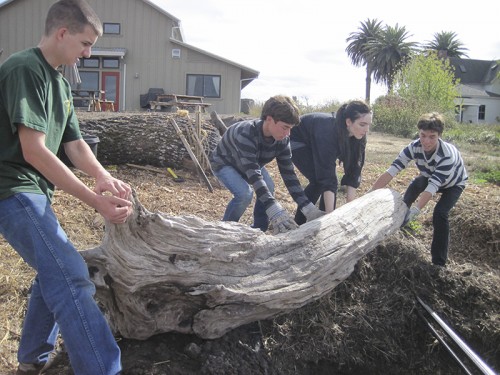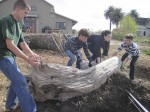
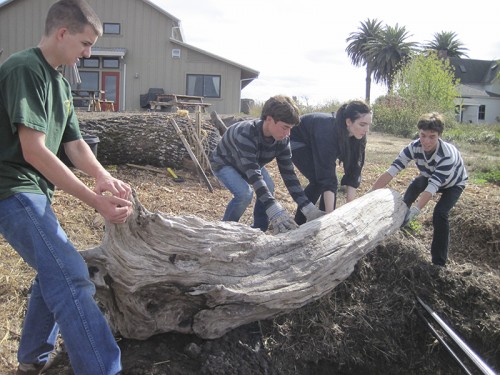 Torrent Critter Crag is a wildlife habitat installed next to Amphibian Amphitheatre at the Laguna Foundation’s headwater Irwin Creek property, the Laguna Environmental Center, or LEC, at 900 Sanford Road, Santa Rosa, California, 95401. The installation was an outdoor classroom activity. Date: October 13, 2016. School: Orchard View School, Sebastopol, California. Teacher: Sunny Galbraith. Me: Tony McGuigan, from Spore Lore.
Torrent Critter Crag is a wildlife habitat installed next to Amphibian Amphitheatre at the Laguna Foundation’s headwater Irwin Creek property, the Laguna Environmental Center, or LEC, at 900 Sanford Road, Santa Rosa, California, 95401. The installation was an outdoor classroom activity. Date: October 13, 2016. School: Orchard View School, Sebastopol, California. Teacher: Sunny Galbraith. Me: Tony McGuigan, from Spore Lore.
In a nutshell, this wildlife habitat installation is a deep clay-lined hole with a large hulk of redwood tree crown/trunk partially buried in it. A large rock slab at ground surface snugs up to the tree crown/trunk. Torrent sedge starts blanket the swale of the habitat.
1 Week Before Habitat Installation
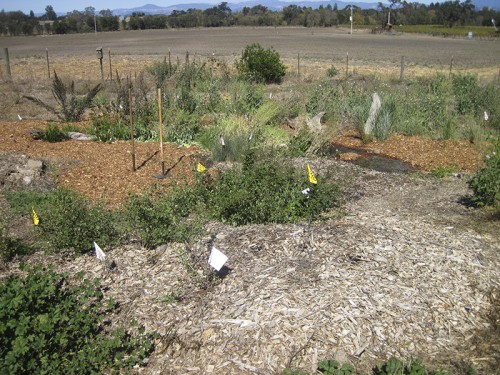 In the pic above, Amphibian Amphitheatre BEFORE Torrent Critter Crag habitat installed. The field behind Amphibian Amphitheatre Ravine‘s berm is lush with tall weeds. Two months have gone by since the area has been weeded. Today, I weed the area to restore dignity to the habitat installations AND to gather organic material for next week’s installation.
In the pic above, Amphibian Amphitheatre BEFORE Torrent Critter Crag habitat installed. The field behind Amphibian Amphitheatre Ravine‘s berm is lush with tall weeds. Two months have gone by since the area has been weeded. Today, I weed the area to restore dignity to the habitat installations AND to gather organic material for next week’s installation.
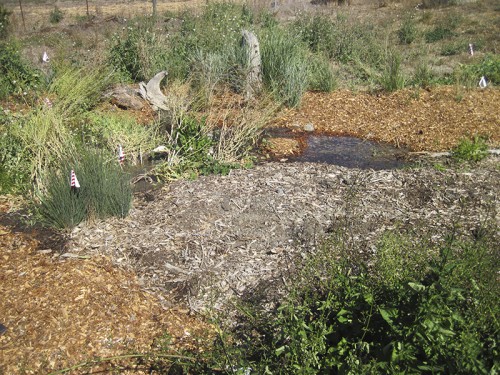 Note the collected water — our berm (created during the Ravine installation) works! Downside: the water is most likely the result of an irrigation line leak. Upside: critters and plants have a swimhole. The next three photos are close-ups from this area on that day of weeding. The dragonfly was at the water’s edge on the tree limb surfacing from the water (far right of the pooled water). The lizard was under the figwort plant in the foreground. The California mantis, Stagmomantis californica, was discovered while weeding golden dry grasses — note how well the mantis is camouflaged.
Note the collected water — our berm (created during the Ravine installation) works! Downside: the water is most likely the result of an irrigation line leak. Upside: critters and plants have a swimhole. The next three photos are close-ups from this area on that day of weeding. The dragonfly was at the water’s edge on the tree limb surfacing from the water (far right of the pooled water). The lizard was under the figwort plant in the foreground. The California mantis, Stagmomantis californica, was discovered while weeding golden dry grasses — note how well the mantis is camouflaged.
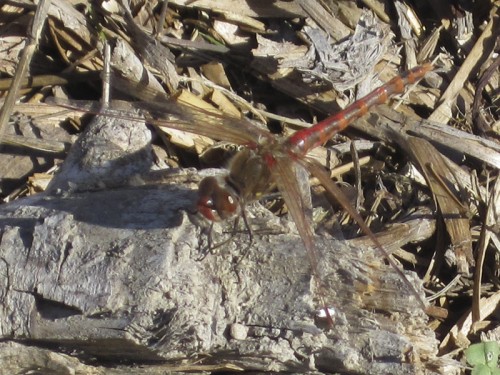 A dragonfly rests alongside the pooled water below Amphibian Amphitheatre Ravine’s berm. Perhaps this is a female Meadowhawk (and there are many species). Can you ID it? Try Kathy Bigg’s, our local Sonoma County dragonfly expert, pages on dragonflies.
A dragonfly rests alongside the pooled water below Amphibian Amphitheatre Ravine’s berm. Perhaps this is a female Meadowhawk (and there are many species). Can you ID it? Try Kathy Bigg’s, our local Sonoma County dragonfly expert, pages on dragonflies.
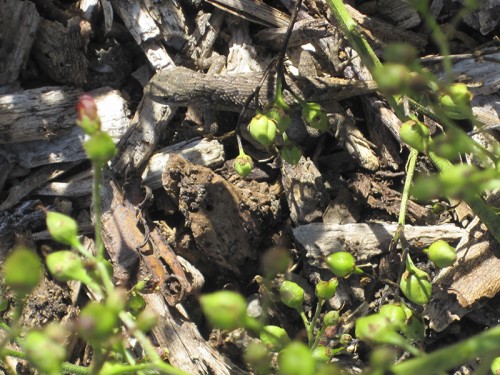 A western fence lizard (Sceloporus occidentalis) is well camoflouged in the woodchips below this California figwort, or Scrophularia californica.
A western fence lizard (Sceloporus occidentalis) is well camoflouged in the woodchips below this California figwort, or Scrophularia californica.
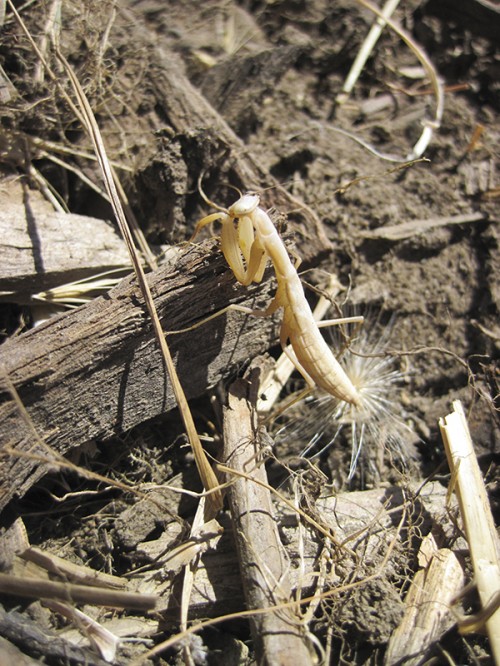 Yikes! Almost weeded this California mantid Stagmomantis californica in Amphibian Amphitheatre. Nice color match on the camo outfit.
Yikes! Almost weeded this California mantid Stagmomantis californica in Amphibian Amphitheatre. Nice color match on the camo outfit.
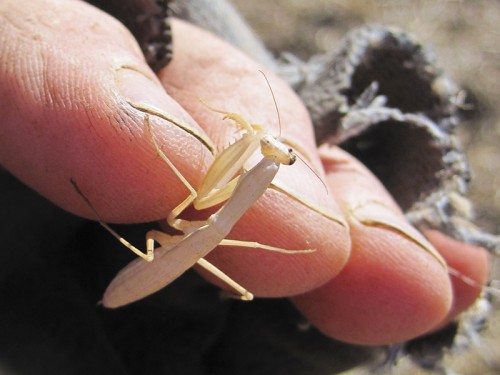 Close-up of California mantid, which are typically 50-60 mm (about 1 1/2 to 2 1/2 inches) long.
Close-up of California mantid, which are typically 50-60 mm (about 1 1/2 to 2 1/2 inches) long.
2 Days Before Habitat Installation
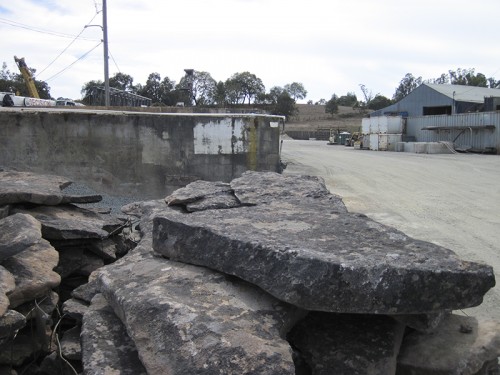 Shopping for rock. These rock slabs make good critter homes. The stack here is Cold Water Canyon rock, local to northern California.
Shopping for rock. These rock slabs make good critter homes. The stack here is Cold Water Canyon rock, local to northern California.
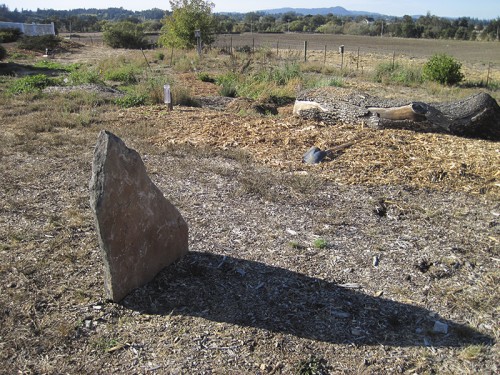 Rock slab being “walked” to the habitat site on the other side of Heron Hall Logs. View is north to Lower Stone Farm and Irwin Creek (line of trees beyond field in background).
Rock slab being “walked” to the habitat site on the other side of Heron Hall Logs. View is north to Lower Stone Farm and Irwin Creek (line of trees beyond field in background).
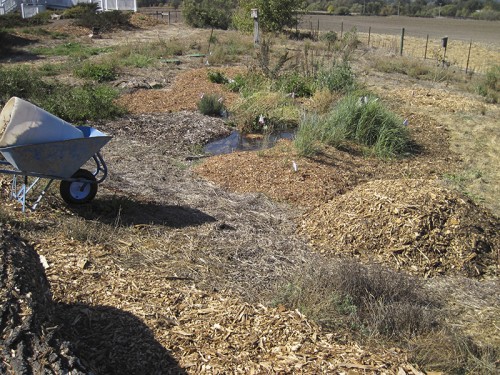 A pile of weeds, in right foreground, has been processing all week. The weeds were pulled from inside Amphibian Amphitheatre and from the downslope meadow. Soil clumps were not shaken from the weeds — many weed clumps had a good sized clump of fresh, healthy, alive topsoil attached to their roots. Weeds (organic matter) and topsoil (soil) were used to make a compost pile (right foreground) that would have only one week to sit before being planted on as a berm. The weeds were thickly covered with layers of woodchips and a scattering of compost. Normally, woodchip mulch does not include compost soil, but this wildlife habitat installation is on the cheap. Materials on hand are ALL the materials we will ever need! The woodchips used were collected from the remnants of two piles — one woodchip pile and one compost/planting mix pile. So, the woodchips have a high component of compost mixed in — perhaps the berm we create for the installation will be a perfect mix to propagate the wild spreading rye already thriving in Amphibian Amphitheatre.
A pile of weeds, in right foreground, has been processing all week. The weeds were pulled from inside Amphibian Amphitheatre and from the downslope meadow. Soil clumps were not shaken from the weeds — many weed clumps had a good sized clump of fresh, healthy, alive topsoil attached to their roots. Weeds (organic matter) and topsoil (soil) were used to make a compost pile (right foreground) that would have only one week to sit before being planted on as a berm. The weeds were thickly covered with layers of woodchips and a scattering of compost. Normally, woodchip mulch does not include compost soil, but this wildlife habitat installation is on the cheap. Materials on hand are ALL the materials we will ever need! The woodchips used were collected from the remnants of two piles — one woodchip pile and one compost/planting mix pile. So, the woodchips have a high component of compost mixed in — perhaps the berm we create for the installation will be a perfect mix to propagate the wild spreading rye already thriving in Amphibian Amphitheatre.
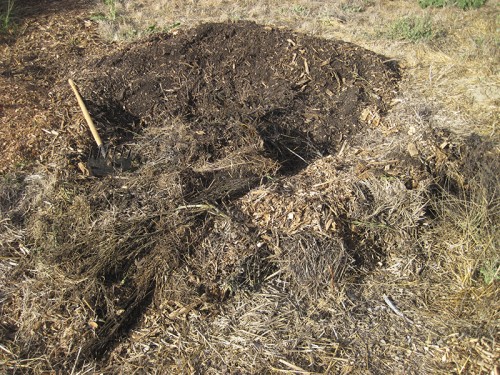 The compost pile is pretty much sitting on top of where Torrent Critter Crag habitat will be installed. The heavier soil and woodchips are pulled to the back of the pile, creating a berm that extends Amphibian Amphitheatre’s berm — more water will be trapped in Amphibian Amphitheatre when the rains come. The lighter decaying weed pile is pulled to away/uphill from the berm; the weeds are moved uphill from the hole to be dug for the habitat. After the habitat hole is dug and the habitat’s wood feature is installed, the weeds will be tucked into the remaining hole to create a cache of underground organic matter, AKA buried treasure!
The compost pile is pretty much sitting on top of where Torrent Critter Crag habitat will be installed. The heavier soil and woodchips are pulled to the back of the pile, creating a berm that extends Amphibian Amphitheatre’s berm — more water will be trapped in Amphibian Amphitheatre when the rains come. The lighter decaying weed pile is pulled to away/uphill from the berm; the weeds are moved uphill from the hole to be dug for the habitat. After the habitat hole is dug and the habitat’s wood feature is installed, the weeds will be tucked into the remaining hole to create a cache of underground organic matter, AKA buried treasure!
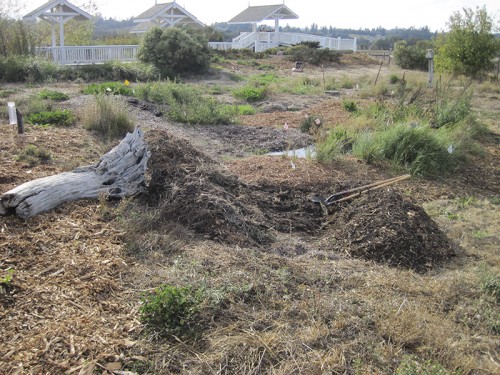 The redwood tree crown-trunk is brought on site. Note the two distinct piles sorted from the compost pile — soil and woodchips right (which will become a planted berm) and one-week-old dead weeds left (which will be buried alongside the crown-trunk).
The redwood tree crown-trunk is brought on site. Note the two distinct piles sorted from the compost pile — soil and woodchips right (which will become a planted berm) and one-week-old dead weeds left (which will be buried alongside the crown-trunk).
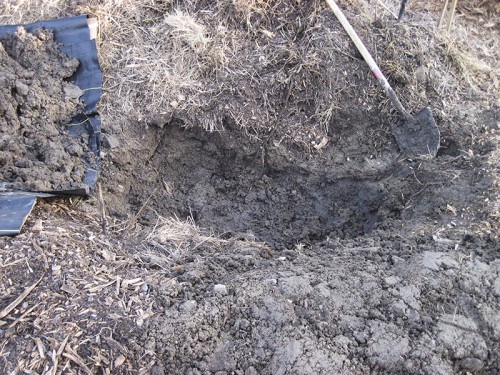 Digging produces heavy clay mud quickly. Note how some of the mud was used to build up the berm in right foreground. Note the black plastic landscaping tarp used to keep the hole’s mud separate (and movable) from the ground below the pile.
Digging produces heavy clay mud quickly. Note how some of the mud was used to build up the berm in right foreground. Note the black plastic landscaping tarp used to keep the hole’s mud separate (and movable) from the ground below the pile.
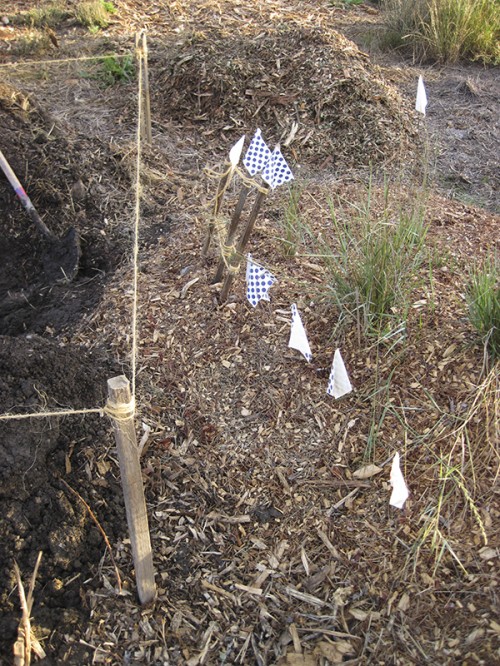 Stakes, string, and flags used to safely leave the hole overnight (left) and protect the rye grass that was planted last year (right).
Stakes, string, and flags used to safely leave the hole overnight (left) and protect the rye grass that was planted last year (right).
Installation Day
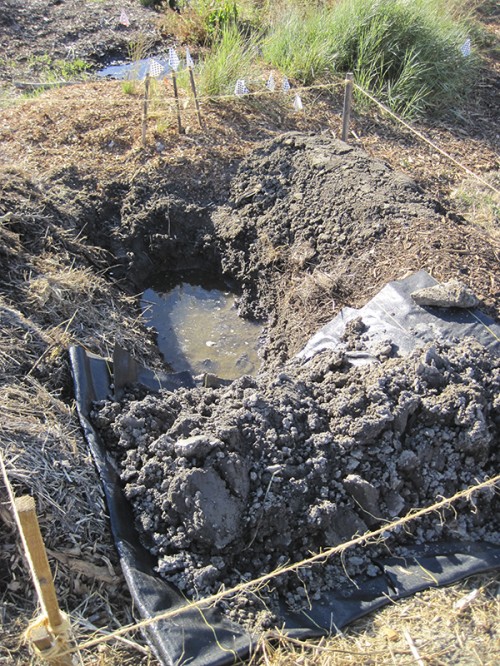 Water in the hole! Lucky me, there won’t be any more digging today. The water has seeped in through the surrounding clay basin — note the pooled water in the background, which is water held uphill by Amphibian Amphitheatre’s berm. Note the materials layout: left = organics (weeds) pile and redwood crown-trunk for burying; foreground = mud pile for surounding buried organics and crown-trunk; right = berm to receive torrent sedge planting; background left (out of view) = woodchip pile to mulch the new planting and suppress weeds over the habitat. Time for the students to take over.
Water in the hole! Lucky me, there won’t be any more digging today. The water has seeped in through the surrounding clay basin — note the pooled water in the background, which is water held uphill by Amphibian Amphitheatre’s berm. Note the materials layout: left = organics (weeds) pile and redwood crown-trunk for burying; foreground = mud pile for surounding buried organics and crown-trunk; right = berm to receive torrent sedge planting; background left (out of view) = woodchip pile to mulch the new planting and suppress weeds over the habitat. Time for the students to take over.
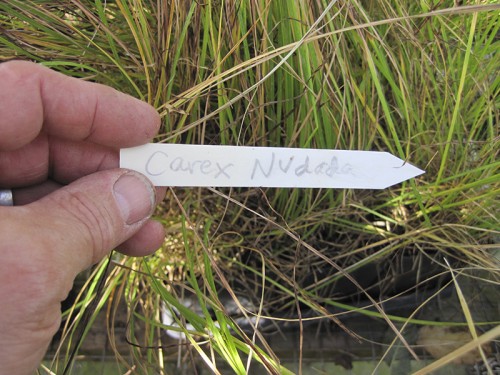 Torrent sedge Carex nudata plants for this habitat have been grown at the Laguna Foundation’s Native Plant Nursery. Torrent sedge grows in mounds below the high-water mark in marshes and on river banks — perfect for this swale area that is expected to gather and hold water.
Torrent sedge Carex nudata plants for this habitat have been grown at the Laguna Foundation’s Native Plant Nursery. Torrent sedge grows in mounds below the high-water mark in marshes and on river banks — perfect for this swale area that is expected to gather and hold water.
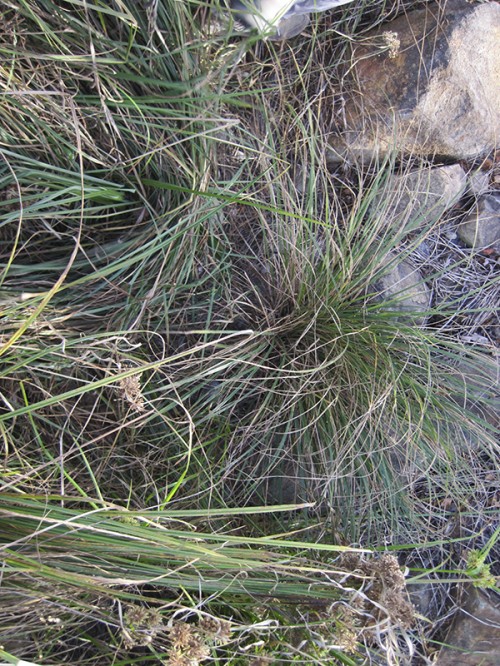 A thriving clump of torrent sedge in the Pond swale at the LEC.
A thriving clump of torrent sedge in the Pond swale at the LEC.
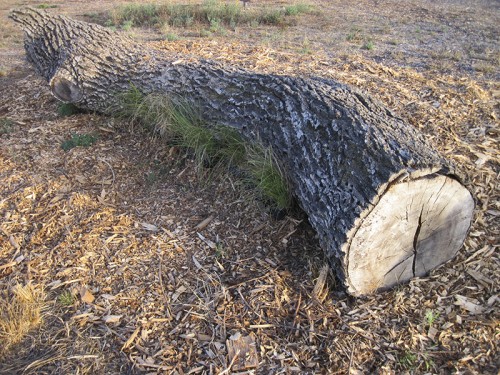 Torrent sedge prepped for the students to plant. The plants were cut out of their 4X4 pots and stored under a Heron Hall log for easy, quick access.
Torrent sedge prepped for the students to plant. The plants were cut out of their 4X4 pots and stored under a Heron Hall log for easy, quick access.
The Students Have Arrived
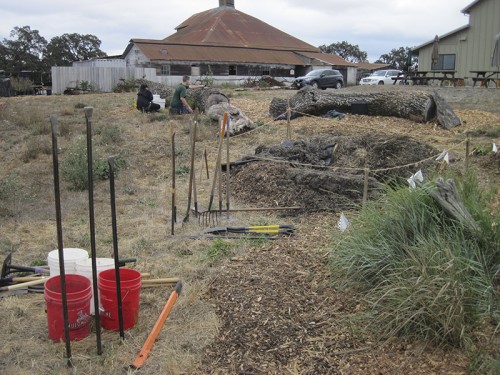 Two hours to wrap up this project! Students prepare the torrent sedge transplants by giving them a “haircut” — trimming the sedge stalks will ensure that the roots will not become overwhelmed and will increase the transplanting survival rate.
Two hours to wrap up this project! Students prepare the torrent sedge transplants by giving them a “haircut” — trimming the sedge stalks will ensure that the roots will not become overwhelmed and will increase the transplanting survival rate.
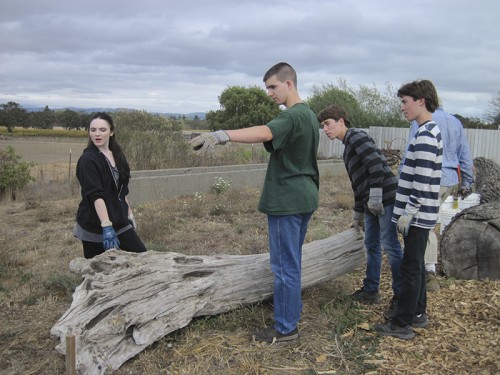 Deciding how to place crown-trunk in the habitat is a collaborative student decision.
Deciding how to place crown-trunk in the habitat is a collaborative student decision.
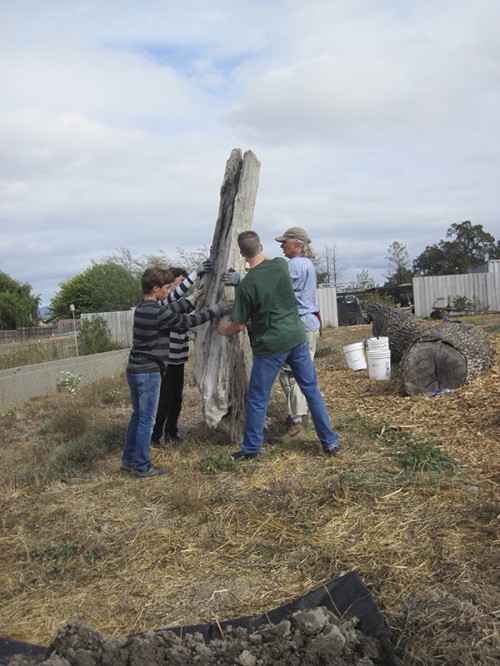 All hands on deck, working together to find the wood hulk’s center of gravity, which will help us know how to move it into position in the hole.
All hands on deck, working together to find the wood hulk’s center of gravity, which will help us know how to move it into position in the hole.
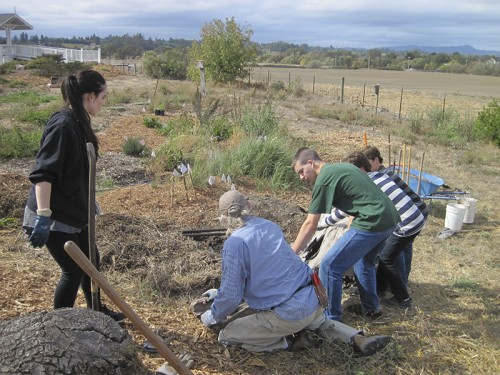 Flipping the crown-trunk into position — sure beats lifting it.
Flipping the crown-trunk into position — sure beats lifting it.
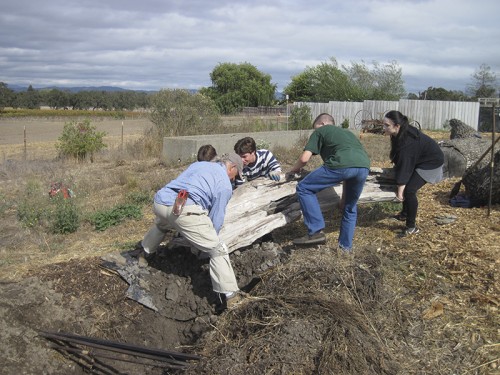 The crown-trunk is headed to the digging bars straddling the hole. The digging bars will suspend the wood over the hole in case we want to make any last minute position changes.
The crown-trunk is headed to the digging bars straddling the hole. The digging bars will suspend the wood over the hole in case we want to make any last minute position changes.
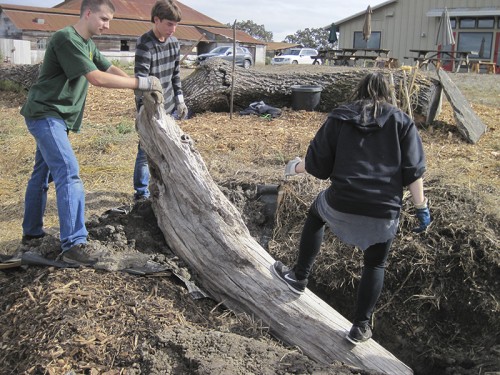 There! A student presses crown-trunk into the muddy hole. Note how the students have decided to bury crown-trunk’s thin end, leaving the bulk to breach (yes, like a whale!) out of the soil. Also, the west facing slope of the wood is designed to attract sunning reptiles that might live under the habitat’s rock slab (in background, waiting to be installed).
There! A student presses crown-trunk into the muddy hole. Note how the students have decided to bury crown-trunk’s thin end, leaving the bulk to breach (yes, like a whale!) out of the soil. Also, the west facing slope of the wood is designed to attract sunning reptiles that might live under the habitat’s rock slab (in background, waiting to be installed).
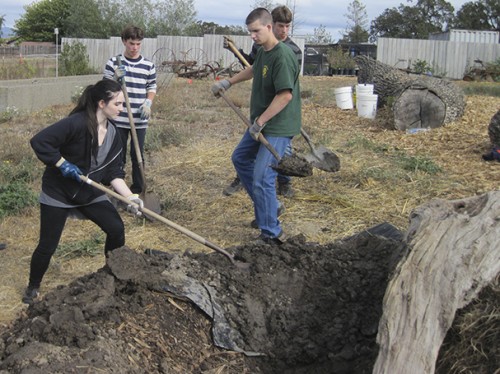 Opps! The log is flipped to the side of the hole to move the heavy clay mud pile from underneath it. We moved the mud to the planting berm for temporary keeping.
Opps! The log is flipped to the side of the hole to move the heavy clay mud pile from underneath it. We moved the mud to the planting berm for temporary keeping.
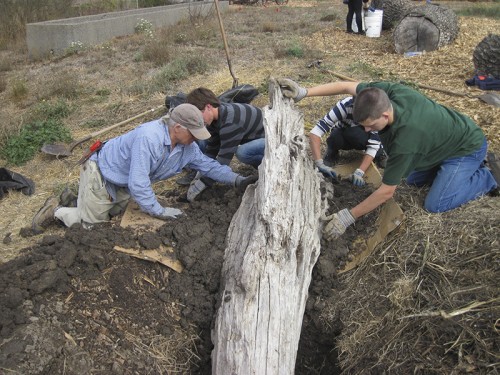 The crown-trunk log is secured in place with clay mud. The cardboard “dropcloth” used to keep the site natural looking is removed.
The crown-trunk log is secured in place with clay mud. The cardboard “dropcloth” used to keep the site natural looking is removed.
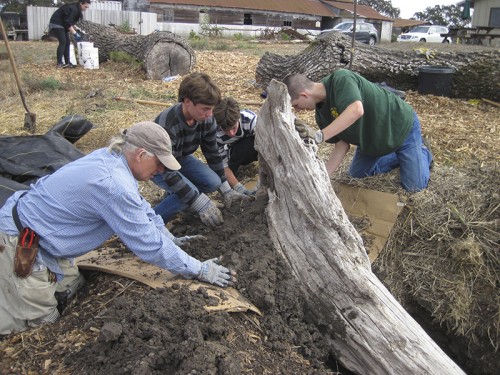 Clay mud is worked around the base of the wood to secure it in place and to create a base for the torrent sedge planting.
Clay mud is worked around the base of the wood to secure it in place and to create a base for the torrent sedge planting.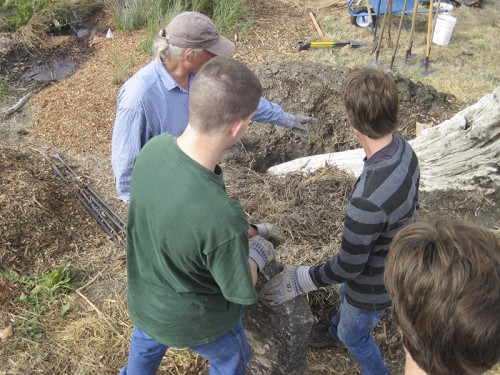 Students hold the rock slab vertical while design elements are discussed.
Students hold the rock slab vertical while design elements are discussed.
 Moving some of the weed pile into the hole so that the rock slab can rest up against the log.
Moving some of the weed pile into the hole so that the rock slab can rest up against the log.
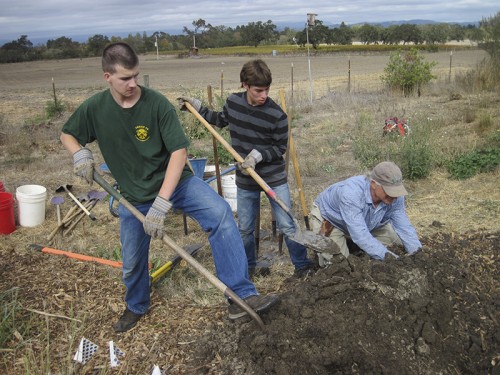 Time to fill the hole, grade the habitat soil. We are skimming the clay mud off the top of the berm, stopping at the layer of woodchips that will become the planting surface.
Time to fill the hole, grade the habitat soil. We are skimming the clay mud off the top of the berm, stopping at the layer of woodchips that will become the planting surface.
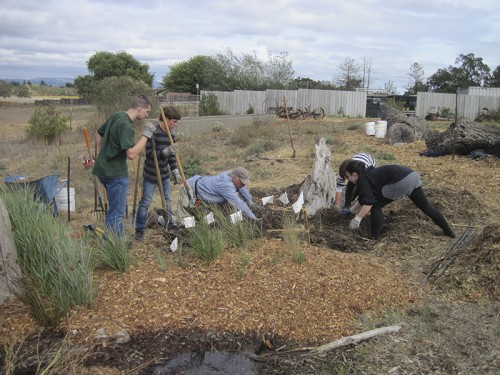 Final grading of the planting mix. Note how little of the log is visible above ground.
Final grading of the planting mix. Note how little of the log is visible above ground.
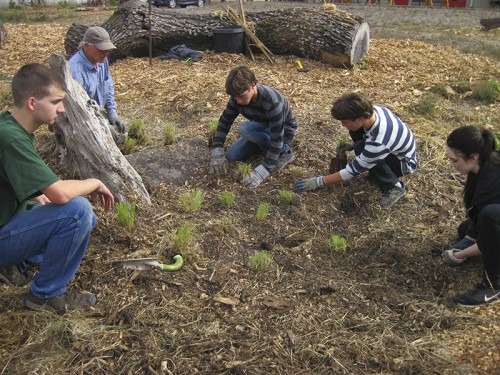 Planting plugs of torrent sedge with 18″ spacing. Some day, these sedge bunches will spread together, hiding the rock slab (right of log). Plenty of critter homes to be had!
Planting plugs of torrent sedge with 18″ spacing. Some day, these sedge bunches will spread together, hiding the rock slab (right of log). Plenty of critter homes to be had!
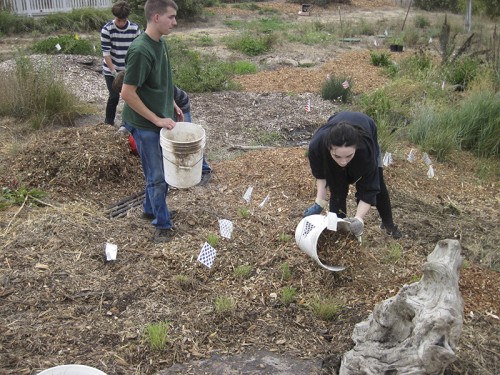 Woodchip mulch to surround the sedge plugs.
Woodchip mulch to surround the sedge plugs.
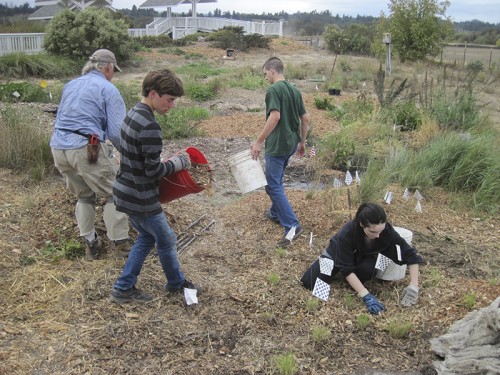 And more woodchips. This is the fun part — our mud hole is beginning to look like something pretty.
And more woodchips. This is the fun part — our mud hole is beginning to look like something pretty.
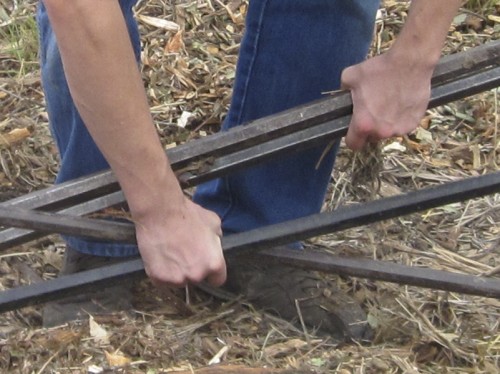 Okay Class, put your paper and pencils away and take out your digging bars. Outdoor classrooms rock!
Okay Class, put your paper and pencils away and take out your digging bars. Outdoor classrooms rock!
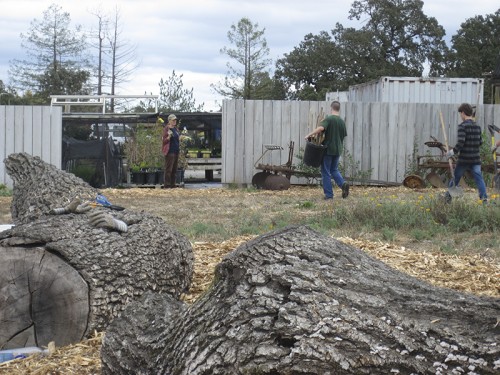 Teacher Sunny Galbraith calls in the cleanup.
Teacher Sunny Galbraith calls in the cleanup.
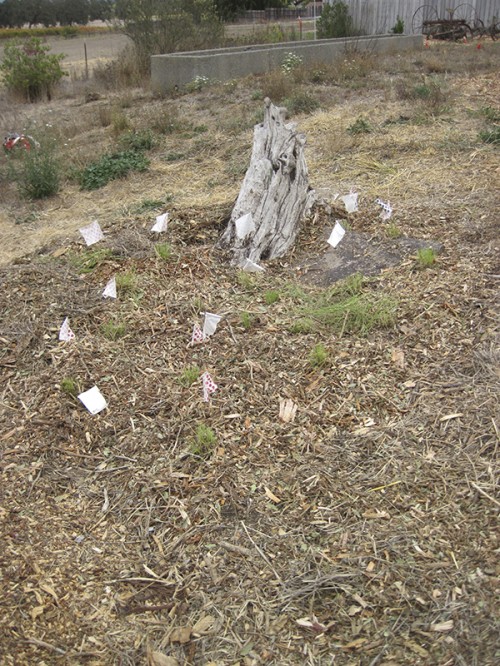 Torrent Critter Crag wildlife habitat installation is in! Northeast view.
Torrent Critter Crag wildlife habitat installation is in! Northeast view.
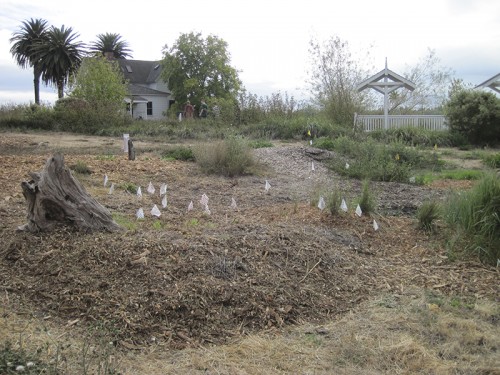 Torrent Critter Crag, southwest view. Teacher Sunny and her students, in background by the Laguna Foundation’s office, visit habitats installed by previous students.
Torrent Critter Crag, southwest view. Teacher Sunny and her students, in background by the Laguna Foundation’s office, visit habitats installed by previous students.
2 Days After Installation
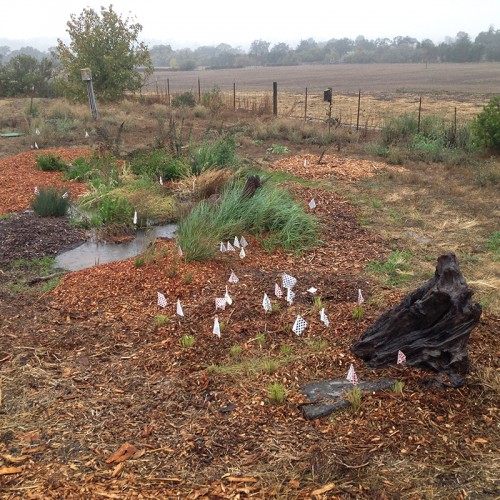 Torrent Critter Crag enjoys its first rain. Northwest view.
Torrent Critter Crag enjoys its first rain. Northwest view.
And more rain will come this winter season, perhaps pooling at the base of crown-trunk log and flooding the torrent sedge. Rain on!
Thank you, as always, to Sunny Galbraith, teacher at Orchard View School, Sebastopol, and her students. Also, much thanks to the staff and board of the Laguna Foundation, particularly the Restoration and Conservation Science Department: Wendy Trowbridge, Director; Brent Reed, Manager, Aaron Nunez, Tech II, and Paul Weber, Tech I.
Enjoy your wildlife habitat installations. Habitat it!
Tony

